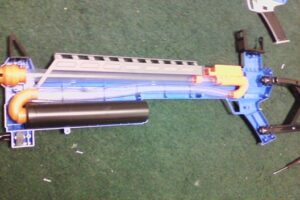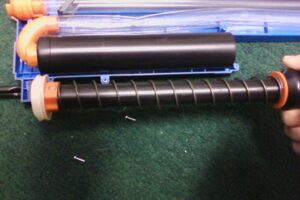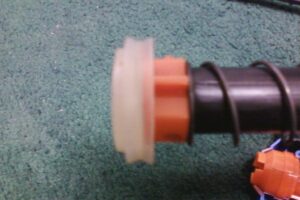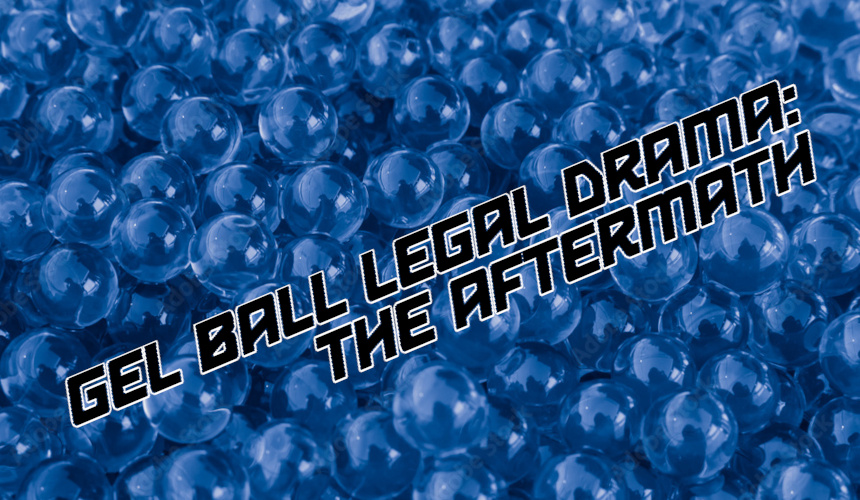
Gel Ball News: Hasbro “Owns” the Market Now? Part 2
March 13, 2024At the end of last year, I wrote an article going partway through the legal battle surrounding gel ball blasters. Life then happened, and I didn’t get around to writing Part 2. Turns out that’s a good thing, because a lot has happened in the meantime. In any case, it would appear that Hasbro has ultimate say in the market. After all, most of the companies with gel ball blasters still being put on shelves have a licensing agreement with Hasbro – not to mention that in many stores, Nerf Pro Gelfire is in the toy aisle, while others are stuck in sporting goods.
Let’s get back into the legal drama, shall we?
The USITC Trial – Featuring only Prime Time Toys
Transcripts:
Prior to the official hearings regarding potential patent infringement, Hasbro reached settlements with Gel Blaster and Splat-R-Ball; that left just Prime Time Toys to defend themselves against Hasbro. Both sides provided exhibits, expert witnesses, etc., and in the hearing the witnesses were questioned by both sides, as well as USITC personnel (who ask questions to clarify issues in the entire situation, as opposed to trying to advance one side or the other).
 In the hearings, Prime Time Toys chose to attack the obviousness of the patents at issue; saying that given the potential injuries from things like airsoft or paintball, and the desire for more range than dart blasters, soft or break-apart materials are an obvious choice. They demonstrated that the mechanics of the various blasters were derivatives of prior art, namely, patents by Nagayoshi and Peev (Japanese and Bulgarian patents, of all things). Given these expired patents demonstrate every claim aside from the use of Super-Absorbent Polymers (SAPs), they were important to show. On a side note, it’s interesting to see the history of various airsoft mechanisms (just look at the drawings).
In the hearings, Prime Time Toys chose to attack the obviousness of the patents at issue; saying that given the potential injuries from things like airsoft or paintball, and the desire for more range than dart blasters, soft or break-apart materials are an obvious choice. They demonstrated that the mechanics of the various blasters were derivatives of prior art, namely, patents by Nagayoshi and Peev (Japanese and Bulgarian patents, of all things). Given these expired patents demonstrate every claim aside from the use of Super-Absorbent Polymers (SAPs), they were important to show. On a side note, it’s interesting to see the history of various airsoft mechanisms (just look at the drawings).
In addition, PTT argued that several SAP or similar products previously on the market had been demonstrated as being capable of launching at targets/people without harm. I’ll let you read/Google, but Clear Spheres and Spitballs in particular were cited as things shown to absorb large amounts of water, and capable of launching (usually via blowpipe). They also used expert witnesses to demonstrate that making spherical SAP rounds of particular size, shape, and firmness weren’t a new concept at the time, and easy to do for someone familiar with that area of knowledge. Finally, they tried to show that there was motivation to combine airsoft and SAPs for safety reasons, compared to airsoft.
In return, Hasbro’s lawyers argued that the patents covered all spring-powered blasters that use SAP ammo, based on the wording of the patent claims. In addition, there were efforts made to show that some of the experts present wouldn’t have had motivation to mate blasters and SAPs in the same manner that PTT argued (given the anecdotal nature of that line of questioning, it did seem suspect to me). Another line of questioning sought (successfully, in this case) to demonstrate, based on the submitted evidence and testimony, that using SAPs in place of airsoft wasn’t feasible because they would detract from the mil-sim aspects of airsoft, or from hunting (yes, this was an actual point made). There were even efforts to show that, given existing products (Clear Spheres, etc), it would be difficult or impossible to use those in airsoft guns or other blasters, so using SAPs would be nonobvious.
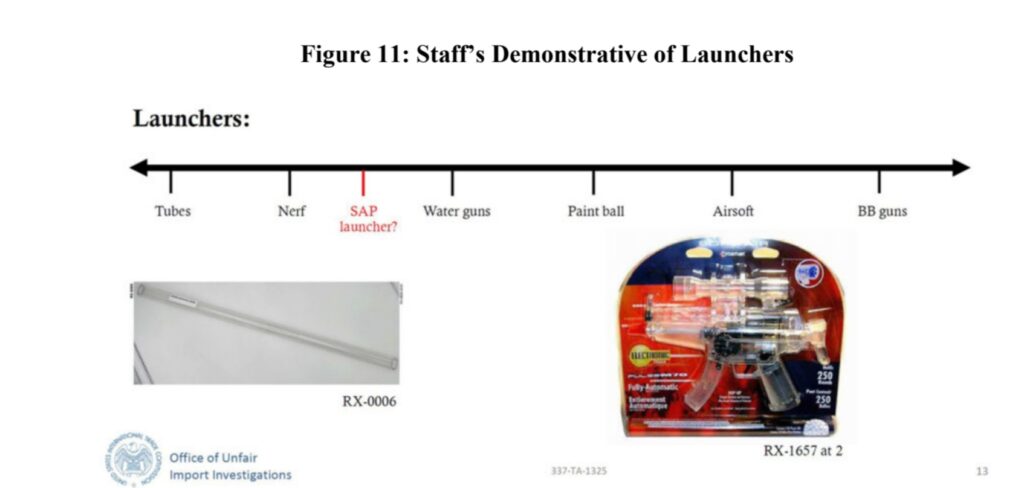 Also, there was a point where the USITC Investigative staff tried to classify where gel blasters line up among other types of blasters/guns. It was…questionable.
Also, there was a point where the USITC Investigative staff tried to classify where gel blasters line up among other types of blasters/guns. It was…questionable.
In the end, it was ruled that the mating of the two concepts was nonobvious, among other issues. Hasbro also successfully argued that there was a domestic industry in development that was being unfairly competed against by the opposition.
Now, PTT is running out of options – while the commission did vote to further examine issues of obviousness, it would seem that is a matter of making a more precise ruling, not ruling in PTT’s favor. PTT is also seeking to challenge the validity of the patent itself (what should have happened years ago), in an inter partes review (“legalese” is annoying with all the Latin terms), but the fact that there was a USITC trial ruling against them means they’re starting from a disadvantaged position.
Author edit: I forgot to mention the debate over the need for something safer than airsoft as a motivation to combine ideas. Things like reducing the compression chamber or spring strength were discussed as viable solutions, but seemingly no time was spent on how a gel round compressing and bursting on impact would disperse much more energy in comparison to a plastic pellet. Alas, something obvious got missed by lawyers.
Now For The Long and Winding Opinion Piece!
In reading the transcripts and researching this topic, I’m amazed at how many things weren’t shown in court, how many mechanisms and concepts were misunderstood, and how a key claim has been ignored. Perhaps things just get lost in translation once legal gets involved? I’ll choose to remain optimistic about things.
I’ll also leave things like “airsoft is used for hunting” alone, because frankly that doesn’t even deserve a rebuttal.
Also, I may have felt compelled enough to submit a letter after learning I could do so, even if there was no point in the process where I would have had an effect. I’ve organized thoughts better since then, but something had to be on the record.
The issue at hand, at least as far as I see it, is that no one has ever challenged the validity of the patents with respect to Claim 7 of US8640683 (“The system of claim 5, wherein the projectile launcher is adapted to load the soft-projectiles”) and the similar Claim 8 of US8371282. As best as I understand it, “adapted to” means to be specifically configured for that function, as opposed to being capable of it. If you’re at all familiar with the Nerf hobby and blaster modification, then you have an idea of what I’m talking about. For example, something as technically simple as slapping a different barrel on your blaster can make it fire something else, but in legal terms, you didn’t adapt it to do something else. It’s not made for that specific purpose.
The relevant case here is In re Giannelli, where the Federal Circuit reversed a decision involving a rowing machine. The Patent Office initially rejected the patent by using a chest press as prior art, since in theory you could face the chest press, pull on the handles, and accomplish the same thing. On final appeal, the Federal Circuit corrected the Patent Office, stating that being designed for a specific function is critical to the validity of a patent, as opposed to pointing at a previous invention and saying “if you use it wrong, you can accomplish the same thing”.
By that standard, the patents in question here are valid because the invention at hand (the Xploderz blasters) was adapted to load the SAP ammo in question. The rounds were relatively lacking in firmness, and thus they required not just a large plunger communicating with a smaller barrel, but a long connection to said barrel to gently accelerate the SAPs (high volume, low pressure). The tube could extend straight ahead, of course, but the smaller tube leading the barrel still has to be there for the airflow purposes.. In the first generation of Xploderz, there was even a “carrier” that the SAP loaded into – pulling back the plunger sucked that carrier backwards into the breech area, dropped the round in front of it, and then held the round as the duo accelerated forward upon plunger release. There may have been tweaks on later releases (even mechanisms for firing 1,2, or 3 rounds at a time), but the aim was the same, due to the fragility of the ammo. Even in the patent descriptions, regardless of whether the carrier was there:
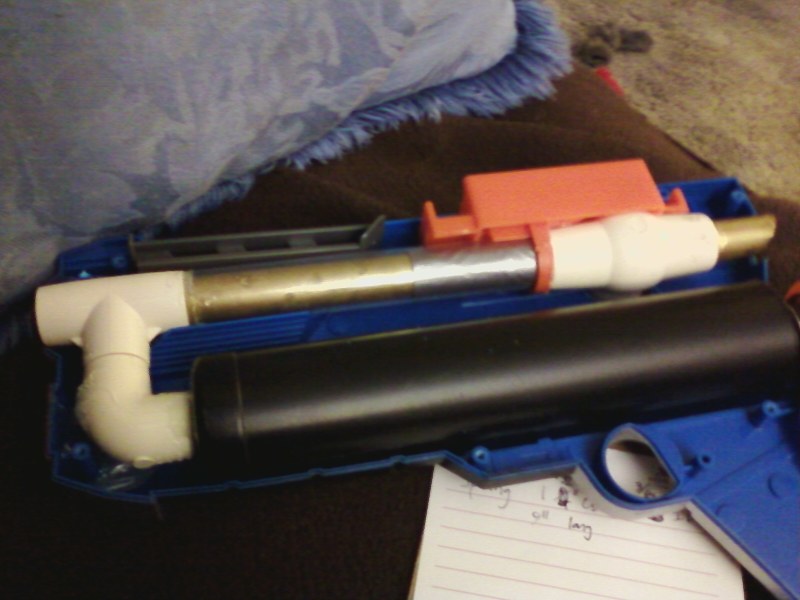
One of my old mods from the initial Xploderz release (Xblaster 200), modified to launch stefans (homemade half darts). Adapted yes, but not “adapted”.
The soft-projectile holder 14 is preferably designed to minimize, or even prevent altogether, the contact of the soft-projectile 16 with the barrel 15 as the soft-projectile 16 travels down the barrel 15. Although soft-projectile holder 14 is not a requirement, minimizing the contact between the soft-projectile 16 and the barrel 15 is preferable. The soft-projectile 16 will tend to retain its shape, especially if the cross-ink density is high. However, if the soft-projectile 16 is nicked, scratched, or damaged by the barrel as it accelerates, it may disintegrate prior to exiting the barrel 15, especially if the cross-ink density is low. If the soft-projectile 16 disintegrates prior to exiting the barrel 15, the soft-projectile 16 will not fly accurately or the correct distance. (US8371282)
Logically, it can be reasoned that for this invention, “adapted to” refers to the arrangement of such elements to allow the SAP ammo in question to be fired without disintegrating. Later models did seem to have some issues here, based on personal experience. After all, the ammo itself on later generations was the same (ranging in size from 7-11mm), but the barrels were 10mm in diameter on the inside (modders know this because we harvested said barrels for firing Boomco darts) and lacking a carrier. So undersized ammo could hit the side of the barrel and be damaged, and oversized ammo wouldn’t fire as well (or would also come apart). Regardless, the blasters were adapted to load the old style SAP rounds.
Compare that with modern day gel ball blasters. They’re using airsoft internals to fire firmer ammo, which is loaded through airsoft-like mechanisms, using barrels that are sized very close to the round size in order to harvest the high-pressure air blast’s energy. These blasters aren’t adapted to firing SAPs because there’s no need with the modern SAP formulations. It’s a different beast altogether compared to Xploderz! And since, as the hearings showed, the knowledge for tweaking SAPs for firmness and sphere diameter has existed for quite some time, it may as well be two different ammo types.
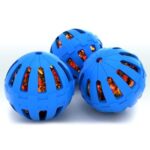 If you want another comparison between ammo, consider the fact that the Xploderz line included “grenades” which you filled with ammo and threw against a hard surface to get the exploding effect. I highly doubt filling those grenades with modern gel balls (assuming they didn’t fall out) would result in the same effect, considering that even at 150-200fps, not all modern gel balls break apart. They squish and disperse kinetic energy, at least, but not all of them burst apart. Throwing by hand results in a considerably slower velocity. You can see where this is going, I hope. I’d rather not spend the money on Ebay to buy those “grenades” to demonstrate.
If you want another comparison between ammo, consider the fact that the Xploderz line included “grenades” which you filled with ammo and threw against a hard surface to get the exploding effect. I highly doubt filling those grenades with modern gel balls (assuming they didn’t fall out) would result in the same effect, considering that even at 150-200fps, not all modern gel balls break apart. They squish and disperse kinetic energy, at least, but not all of them burst apart. Throwing by hand results in a considerably slower velocity. You can see where this is going, I hope. I’d rather not spend the money on Ebay to buy those “grenades” to demonstrate.
Funny enough, in researching I came across a Quora thread, answered by an established user (and presumably a human being that isn’t writing a BS answer), showing that launching gel balls from airsoft guns is certainly possible. It took finding compatible things that didn’t need adjusted (or, more properly, need adjustments beyond the scope of legal adaptation), but it could be done. Given SAP chemistry was known at the time, using only the large Clear Spheres to show you couldn’t make SAPs fire in regular blasters seems disingenuous at best.
As to the various comments in the hearings about gel detracting from the milsim aspect of airsoft…I’d encourage them to listen to the experience of people in the hobby. This podcast, for example, was before the US legal issues in the hobby took hold. They had other legal issues to discuss (banning of airsoft in various countries, as well as various enforcement issues), but still had plenty of people playing that wanted the “military simulation”.
The US might currently lean towards a more toy-like look for gel ball blasters, but the principles themselves (both for people playing and the blaster mechanisms) aren’t different. They’re derived from airsoft, and it turns out given a firm SAP formulation, no “adapting” is needed.
Even more interestingly, there are industry standards being debated and eventually put into place for SAP launchers, and they recognize that this sport in particular is an airsoft derivative. That’s completely different from what the USITC investigative staff determined, but for hobbyists like me, it makes complete sense.
 Let’s end this opinion piece with a metaphor. Imagine that there’s an existing platform that’s long past patent issues, like automobiles. Someone discovers that a previously unconsidered chemical can be a much more effective fuel, but requires a special engine to utilize it. They make that engine, leading to the production of a car with a unique engine that they can patent. Or at least, that vehicle in combination with the new chemical. Over the next few years, they simplify it, but it’s still made for that new fuel.
Let’s end this opinion piece with a metaphor. Imagine that there’s an existing platform that’s long past patent issues, like automobiles. Someone discovers that a previously unconsidered chemical can be a much more effective fuel, but requires a special engine to utilize it. They make that engine, leading to the production of a car with a unique engine that they can patent. Or at least, that vehicle in combination with the new chemical. Over the next few years, they simplify it, but it’s still made for that new fuel.
Many years later, other people find that a chemical in the same family can simply be used in place of gasoline, without the need for special modification. Does that mean all those Ford and Chevy vehicles in existence are now subject to this patent?
That SHOULD be the logic behind this entire legal battle. Nevertheless, it seems that Hasbro will be taking over the market. Most of the other subjects of the lawsuit have settled with them, and retailers like Walmart have begun removing stock that’s not approved for selling due to this case (the recent Xshot gel blasters, for example, disappeared from shelves after only a few months, even while being sold elsewhere).
Late Edit: Given that it occurred in the same time period, shouldn’t the mere existence of the patent for Gel Ball blasters that Razor USA successfully applied for indicate limitations on the Xploderz patents? After all, Razor did make those blasters, and I can’t currently find evidence of any lawsuits invalidating that patent. And they cited the Xploderz patent, so their existence was presumably known to the related parties. If Maya Group didn’t go after them, most likely for a reason…why can Spin Master and Hasbro do it now?
What’s the audience take on all of this?

